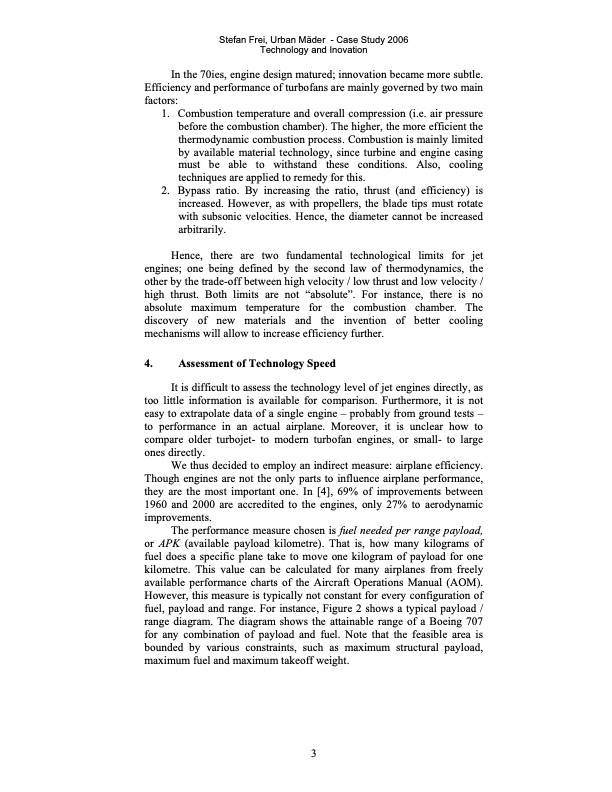
PDF Publication Title:
Text from PDF Page: 003
Stefan Frei, Urban Mäder - Case Study 2006 Technology and Inovation In the 70ies, engine design matured; innovation became more subtle. Efficiency and performance of turbofans are mainly governed by two main factors: 1. Combustion temperature and overall compression (i.e. air pressure before the combustion chamber). The higher, the more efficient the thermodynamic combustion process. Combustion is mainly limited by available material technology, since turbine and engine casing must be able to withstand these conditions. Also, cooling techniques are applied to remedy for this. 2. Bypass ratio. By increasing the ratio, thrust (and efficiency) is increased. However, as with propellers, the blade tips must rotate with subsonic velocities. Hence, the diameter cannot be increased arbitrarily. Hence, there are two fundamental technological limits for jet engines; one being defined by the second law of thermodynamics, the other by the trade-off between high velocity / low thrust and low velocity / high thrust. Both limits are not “absolute”. For instance, there is no absolute maximum temperature for the combustion chamber. The discovery of new materials and the invention of better cooling mechanisms will allow to increase efficiency further. 4. Assessment of Technology Speed It is difficult to assess the technology level of jet engines directly, as too little information is available for comparison. Furthermore, it is not easy to extrapolate data of a single engine – probably from ground tests – to performance in an actual airplane. Moreover, it is unclear how to compare older turbojet- to modern turbofan engines, or small- to large ones directly. We thus decided to employ an indirect measure: airplane efficiency. Though engines are not the only parts to influence airplane performance, they are the most important one. In [4], 69% of improvements between 1960 and 2000 are accredited to the engines, only 27% to aerodynamic improvements. The performance measure chosen is fuel needed per range payload, or APK (available payload kilometre). That is, how many kilograms of fuel does a specific plane take to move one kilogram of payload for one kilometre. This value can be calculated for many airplanes from freely available performance charts of the Aircraft Operations Manual (AOM). However, this measure is typically not constant for every configuration of fuel, payload and range. For instance, Figure 2 shows a typical payload / range diagram. The diagram shows the attainable range of a Boeing 707 for any combination of payload and fuel. Note that the feasible area is bounded by various constraints, such as maximum structural payload, maximum fuel and maximum takeoff weight. 3PDF Image | Technology Speed of Civil Jet Engines

PDF Search Title:
Technology Speed of Civil Jet EnginesOriginal File Name Searched:
innovation_in_civil_jet_aviation_2006.pdfDIY PDF Search: Google It | Yahoo | Bing
NFT (Non Fungible Token): Buy our tech, design, development or system NFT and become part of our tech NFT network... More Info
IT XR Project Redstone NFT Available for Sale: NFT for high tech turbine design with one part 3D printed counter-rotating energy turbine. Be part of the future with this NFT. Can be bought and sold but only one design NFT exists. Royalties go to the developer (Infinity) to keep enhancing design and applications... More Info
Infinity Turbine IT XR Project Redstone Design: NFT for sale... NFT for high tech turbine design with one part 3D printed counter-rotating energy turbine. Includes all rights to this turbine design, including license for Fluid Handling Block I and II for the turbine assembly and housing. The NFT includes the blueprints (cad/cam), revenue streams, and all future development of the IT XR Project Redstone... More Info
Infinity Turbine ROT Radial Outflow Turbine 24 Design and Worldwide Rights: NFT for sale... NFT for the ROT 24 energy turbine. Be part of the future with this NFT. This design can be bought and sold but only one design NFT exists. You may manufacture the unit, or get the revenues from its sale from Infinity Turbine. Royalties go to the developer (Infinity) to keep enhancing design and applications... More Info
Infinity Supercritical CO2 10 Liter Extractor Design and Worldwide Rights: The Infinity Supercritical 10L CO2 extractor is for botanical oil extraction, which is rich in terpenes and can produce shelf ready full spectrum oil. With over 5 years of development, this industry leader mature extractor machine has been sold since 2015 and is part of many profitable businesses. The process can also be used for electrowinning, e-waste recycling, and lithium battery recycling, gold mining electronic wastes, precious metals. CO2 can also be used in a reverse fuel cell with nafion to make a gas-to-liquids fuel, such as methanol, ethanol and butanol or ethylene. Supercritical CO2 has also been used for treating nafion to make it more effective catalyst. This NFT is for the purchase of worldwide rights which includes the design. More Info
NFT (Non Fungible Token): Buy our tech, design, development or system NFT and become part of our tech NFT network... More Info
Infinity Turbine Products: Special for this month, any plans are $10,000 for complete Cad/Cam blueprints. License is for one build. Try before you buy a production license. May pay by Bitcoin or other Crypto. Products Page... More Info
| CONTACT TEL: 608-238-6001 Email: greg@infinityturbine.com | RSS | AMP |